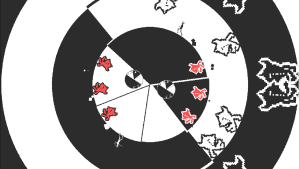If you’ve ever wanted to delve into the endless depths of a kaleidoscope you may want to consider buying Circa Infinity (or at least check out the demo). Despite generating quite a bit of coverage around the time of its release, Circa Infinity has not really taken off and, indeed, seems to have been all but forgotten about by just about everyone only three months later. ‘Experimental puzzle platformer’ is a label which can be applied to far, far too many games these days and at a price of $9.99 for a game which can be finished in about five hours it’s easy to understand why many may be hesitant to make the purchase. Though the trailers do show off a good amount of uncut gameplay, it can be hard to tell just quite how Circa Infinity actually works so I think it’s best to clarify a few things. This is a game about circles and this is a game about opposites and, for the most part, that is all you really need to understand.
Okay, let’s go into a bit more detail than that. In this game, you control an unnamed woman (and/or man depending on the chapter) and the goal is to make it to the end of each stage. The stages themselves consist of multiple sets of black and white circles within circles and you must navigate around both the inside and outside of each circle’s circumference. While a character is on the outside edge of a circle they cannot jump, but they can ‘duck’ by melding into the edge without needing to stop or slow down. This ducking ability is useful for avoiding certain enemies, but its primary purpose while on the outside is to use it while touching a highlighted wedge of the circle to enter the inside of the circle’s outline. The characters lose the ability to duck once they are on the inside, but they gain the ability to jump. Most enemies are short enough that they can be jumped over and the goal once inside a circle is to jump and make contact with a smaller circle which will, in turn, enlarge and become the next circle in the chain.
The first two out of the five chapters in Circa Infinity consist of largely simplistic and straightforward levels which serve to familiarize you with the controls and the various enemy types, but the mind-meltingly clever puzzles don’t really kick in until Chapter 3. Starting from the third chapter you control both the male and the female character simultaneously and the amount of information to keep track of while performing some precise platforming steadily increases. The characters will always be on opposite sides of the circle from each other but not necessarily on the same side of a circle’s edge. A highlighted wedge will disappear once a character uses it to enter the inside of a circle and, while the characters themselves may be eternally opposite of one another, the wedges often are not. Furthermore, the characters can only jump while on the inner side of a circle if both of them are on the same side, otherwise they duck.

This restriction on jumping is particularly important as it makes it much harder to avoid enemies and you will also need to often pay attention to just which of the two entrances into the circle you decide to use first as it may become impossible for the second character to make it to their entrance if a stationary enemy is in the way. Of course, as enemies can be on both the outer and inner sides of a circle, and one enemy in particular is large enough to be a hazard on both a circle’s inner edge and the next circle’s outer edge, you need to constantly split your attention between the two characters in order to keep them safe while also maneuvering them to their goals.
If there is one thing Circa Infinity does particularly well, it is incrementing on multiple levels. In the scope of the game as a whole you will gradually advance from controlling one character, to controlling two characters, to also needing to pay attention to and control the black and white sides of the screen, and eventually even to dealing with additional colors. However, the stages themselves also heavily incorporate the concept of incrementing in their sets of circles. There are quite a few circles to traverse in every stage, but these circles are usually divided into incremental sets with empty, ‘safe’ circles between them, which serve both to break up the sets and to act as checkpoints as getting hit sends the characters back to the outside of the previous circle. Each set of circles usually starts with a basic layout which each additional circle will gradually add more enemies to, such as increasing a group of jumping enemies from three to four and then from four to five, and/or will shift slightly, such as by changing wedge locations or decreasing the size of the circle to leave less room for avoiding enemies. Not only does this repetition with addition result in some remarkable patterns to look at, it also results in a an overall steady and rapidly-flowing pace which keeps up a sense of energy even during the many parts where you will probably need to stop for a moment to let your brain process just what it is the game is asking you to do in order to continue onward.

Circa Infinity deserves to be called visually stunning, but it also has some devious platforming and more likely than not will suddenly introduce a new trick or an entirely new element to completely shake things up just when you start to feel like you have a firm grasp on how everything works. It may be on the short side of things, but it is easily worth its price.